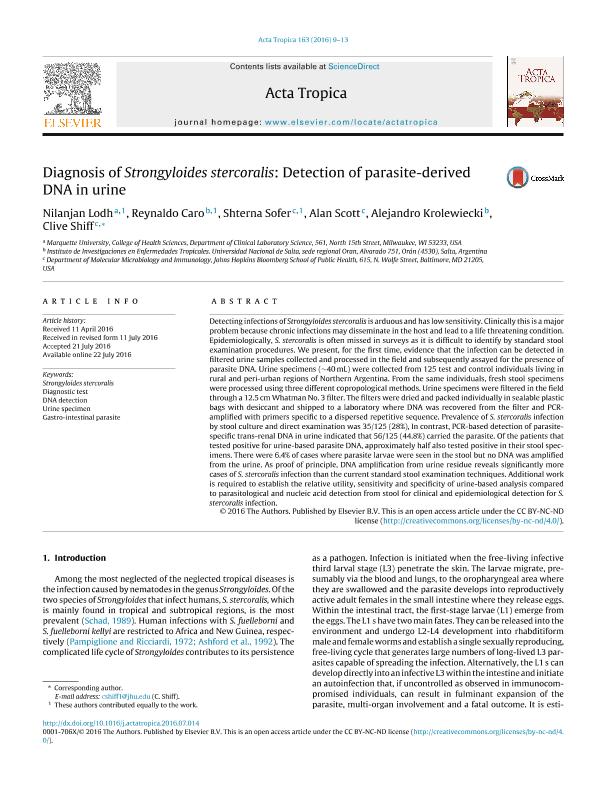Artículo
Diagnosis of Strongyloides stercoralis: Detection of parasite-derived DNA in urine
Lodh, Nilanjan; Caro, Reynaldo; Sofer, Shterna; Scott, Alan; Krolewiecki, Alejandro Javier ; Shiff, Clive
; Shiff, Clive
 ; Shiff, Clive
; Shiff, Clive
Fecha de publicación:
07/2016
Editorial:
Elsevier Science
Revista:
Acta Tropica
ISSN:
0001-706X
Idioma:
Inglés
Tipo de recurso:
Artículo publicado
Clasificación temática:
Resumen
Detecting infections of Strongyloides stercoralis is arduous and has low sensitivity. Clinically this is a major problem because chronic infections may disseminate in the host and lead to a life threatening condition.Epidemiologically, S. stercoralis is often missed in surveys as it is difficult to identify by standard stool examination procedures. We present, for the first time, evidence that the infection can be detected in filtered urine samples collected and processed in the field and subsequently assayed for the presence of parasite DNA. Urine specimens (∼40 mL) were collected from 125 test and control individuals living in rural and peri-urban regions of Northern Argentina. From the same individuals, fresh stool specimens were processed using three different copropological methods. Urine specimens were filtered in the field through a 12.5 cm Whatman No. 3 filter. The filters were dried and packed individually in sealable plastic bags with desiccant and shipped to a laboratory where DNA was recovered from the filter and PCRamplified with primers specific to a dispersed repetitive sequence. Prevalence of S. stercoralis infectionby stool culture and direct examination was 35/125 (28%), In contrast, PCR-based detection of parasitespecific trans-renal DNA in urine indicated that 56/125 (44.8%) carried the parasite. Of the patients that tested positive for urine-based parasite DNA, approximately half also tested positive in their stool specimens. There were 6.4% of cases where parasite larvae were seen in the stool but no DNA was amplified from the urine. As proof of principle, DNA amplification from urine residue reveals significantly more cases of S. stercoralis infection than the current standard stool examination techniques. Additional work is required to establish the relative utility, sensitivity and specificity of urine-based analysis compared to parasitological and nucleic acid detection from stool for clinical and epidemiological detection for S.stercoralis infection.
Archivos asociados
Licencia
Identificadores
Colecciones
Articulos(IPE)
Articulos de INST.DE PATOLOGIA EXPERIMENTAL
Articulos de INST.DE PATOLOGIA EXPERIMENTAL
Citación
Lodh, Nilanjan; Caro, Reynaldo; Sofer, Shterna; Scott, Alan; Krolewiecki, Alejandro Javier; et al.; Diagnosis of Strongyloides stercoralis: Detection of parasite-derived DNA in urine; Elsevier Science; Acta Tropica; 163; 7-2016; 9-13
Compartir
Altmétricas



